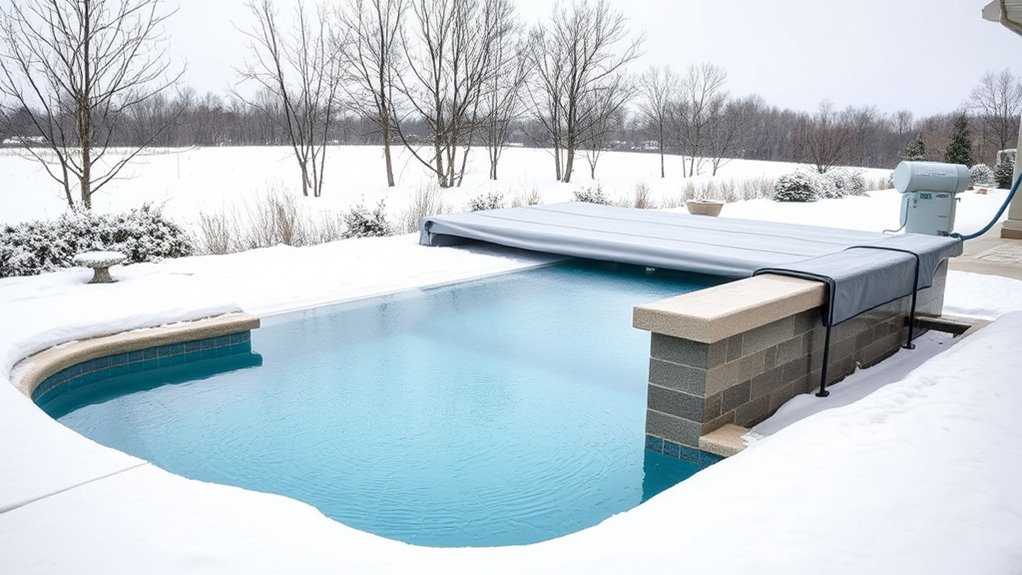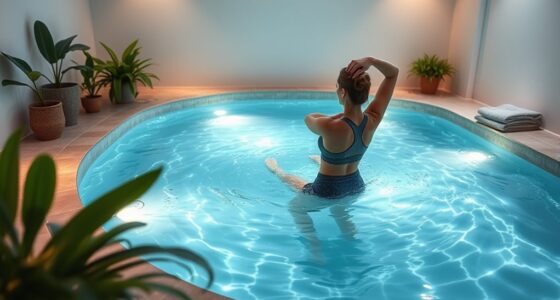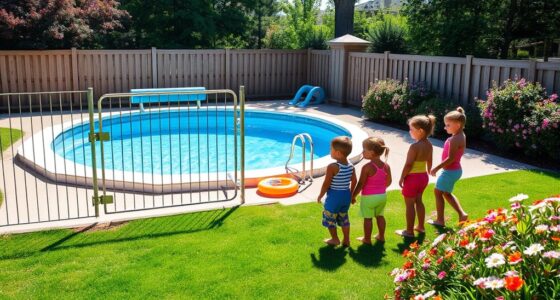To winterize your Endless Pool properly, start by draining all water from the pool and equipment, then thoroughly clean and inspect each component for damage. Balance the water chemistry, adjusting pH and sanitizer levels, and add a suitable antifreeze to protect against freezing. Cover the pool securely with a snug, elevated cover, and store accessories in a dry, ventilated area. Maintain good air circulation around the pool to prevent moisture buildup. If you’re enthusiastic to learn more, you’ll discover detailed steps for a seamless winterization process.
Key Takeaways
- Drain and thoroughly clean all pool components, including the shell, fittings, pump, and heater, before covering.
- Balance water chemistry to recommended levels, then add appropriate non-toxic antifreeze to prevent freezing damage.
- Use a high-quality, snug-fitting winter cover, securing it tightly and elevating edges for proper drainage.
- Disconnect hoses and store accessories in a dry, ventilated area, inspecting for damage and cleaning before storage.
- Ensure proper air circulation and moisture control in the surrounding area to prevent mold, mildew, and component corrosion during winter.
Drain and Remove Water From the Pool and Equipment
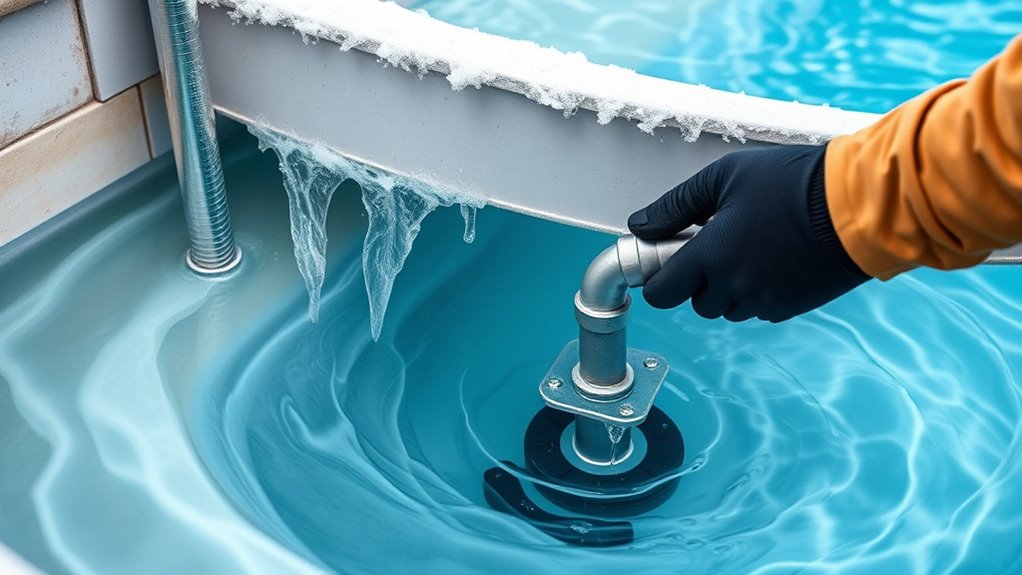
Before winter sets in, you need to drain the water from your Endless Pool and its equipment to prevent damage from freezing. Start by turning off the pool’s power and filtration system. Remove the pool cover and locate the drain plug or valve—usually at the lowest point of the pool. Attach a garden hose to the drain, directing the water away from your home or patio. Open the drain valve and let the water flow out completely. Don’t forget to drain the pump, filter, heater, and any other accessories connected to your pool. Once all water is removed, wipe down surfaces to prevent mold. Properly draining your pool and equipment now helps avoid costly repairs caused by frozen, expanding water. Incorporating proper maintenance techniques ensures your pool remains in optimal condition during the off-season.
Clean and Inspect Your Endless Pool Thoroughly
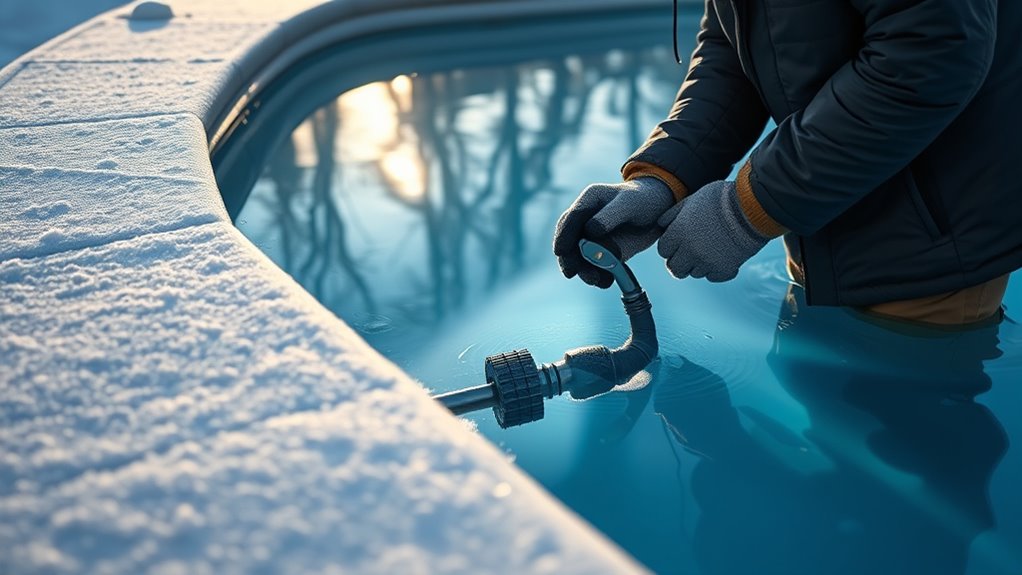
Once you’ve drained your Endless Pool, take the time to thoroughly clean and inspect every component. Use a soft brush or cloth to remove dirt, algae, and debris from the shell, jets, and filter area. Check for cracks, corrosion, or damage to the shell, liner, and fittings. Inspect the pump and heater for leaks or worn parts. Make sure all electrical connections are secure and free of corrosion. Clean the skimmer and filter thoroughly, removing any buildup. If you notice any signs of wear or damage, note them for repair or replacement later. This step guarantees your pool stays in good condition during winter and helps prevent issues when you reopen it. Proper cleaning and inspection are essential for a smooth winterization process. Regular home maintenance and careful inspection can extend the lifespan of your pool equipment and improve overall safety.
Balance the Water Chemistry Before Closing
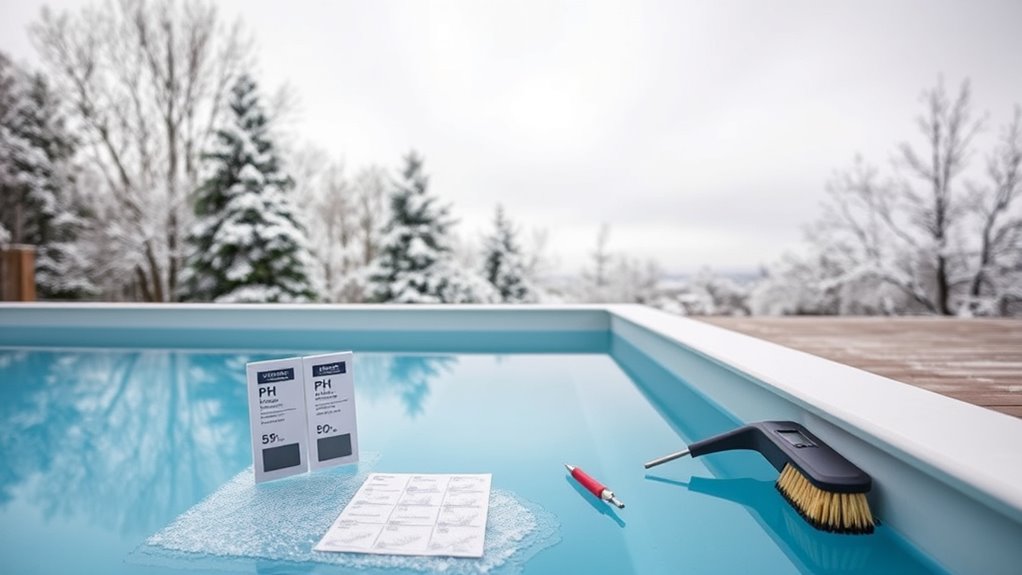
Balancing the water chemistry is a crucial step to guarantee your Endless Pool stays in top condition during the winter months. Properly balanced water prevents corrosion, scaling, and algae growth, ensuring your pool remains in good shape for next season. Test the water using test strips or a liquid test kit, focusing on pH, alkalinity, and sanitizer levels. Adjust these parameters as needed to keep them within ideal ranges:
| Parameter | Suitable Range | Adjustment Method |
|---|---|---|
| pH | 7.2 – 7.6 | Add pH increaser or decreaser |
| Total Alkalinity | 80 – 120 ppm | Use alkalinity adjusters |
| Sanitizer | Recommended levels based on sanitizer type | Add sanitizer or shock |
Maintaining proper chemistry now makes winterization easier and protects your pool. Understanding how these parameters interact ensures you can keep your pool in optimal condition during the off-season.
Add Proper Winterizing Agents and Antifreeze
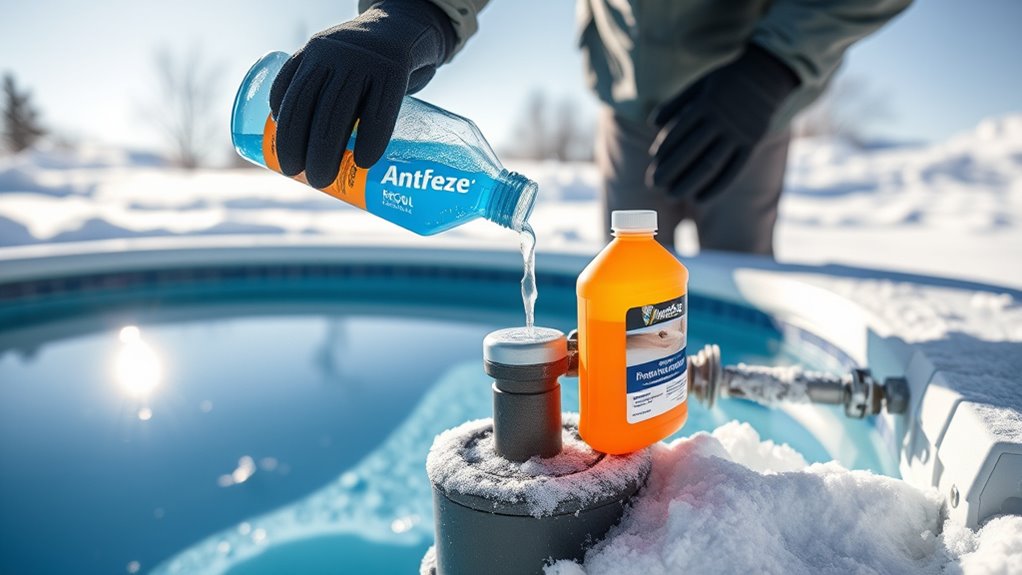
Choosing the right antifreeze is essential to protect your pool’s plumbing during winter. You need to make certain the chemical ratios are correct so the solution prevents freezing without causing damage. Let’s go over how to select the best winterizing agents and get the mix just right.
Choosing the Right Antifreeze
Selecting the right antifreeze is crucial to protect your Endless Pool during winter. You need a non-toxic, pool-safe antifreeze that resists freezing without harming your equipment or environment. Look for propylene glycol-based antifreeze, which is safe for pools and easier to drain later. Avoid automotive antifreeze, as it contains additives harmful to pools and pets. To help you decide, here’s a quick comparison:
| Antifreeze Type | Safety for Pools | Environmentally Friendly | Freeze Protection |
|---|---|---|---|
| Propylene Glycol | Yes | Yes | Up to -50°F |
| Ethylene Glycol | No | No | Up to -60°F |
| Automotive Antifreeze | No | No | Up to -70°F |
| Non-toxic Options | Yes | Yes | Varies |
| Organic Solutions | Yes | Yes | Varies |
Choosing the right antifreeze ensures your pool stays protected without environmental or health risks. Properly draining and storing your equipment after winterizing is also essential to maintain its longevity.
Proper Chemical Ratios
After picking the right antifreeze, it’s important to guarantee your pool’s chemicals are properly adjusted for winter. You want the water balanced to prevent corrosion and scaling. Test the pH, alkalinity, and calcium hardness, and adjust them to recommended winter levels—pH around 7.2-7.6, alkalinity between 80-120 ppm, and calcium hardness at 150-250 ppm. Add the appropriate winterizing chemical agents, such as algaecide or stabilizers, as needed. Ensure the chemical levels are well mixed and stable before adding antifreeze. Proper chemical ratios protect your pool’s surfaces and equipment during the cold months. Avoid over- or under-treating, as imbalance can cause damage. Taking these steps ensures your Endless Pool stays in top shape throughout winter. Regularly monitoring and maintaining proper chemical balance helps prevent issues like corrosion or scaling during the off-season.
Protect the Pool Structure and Cover It Securely
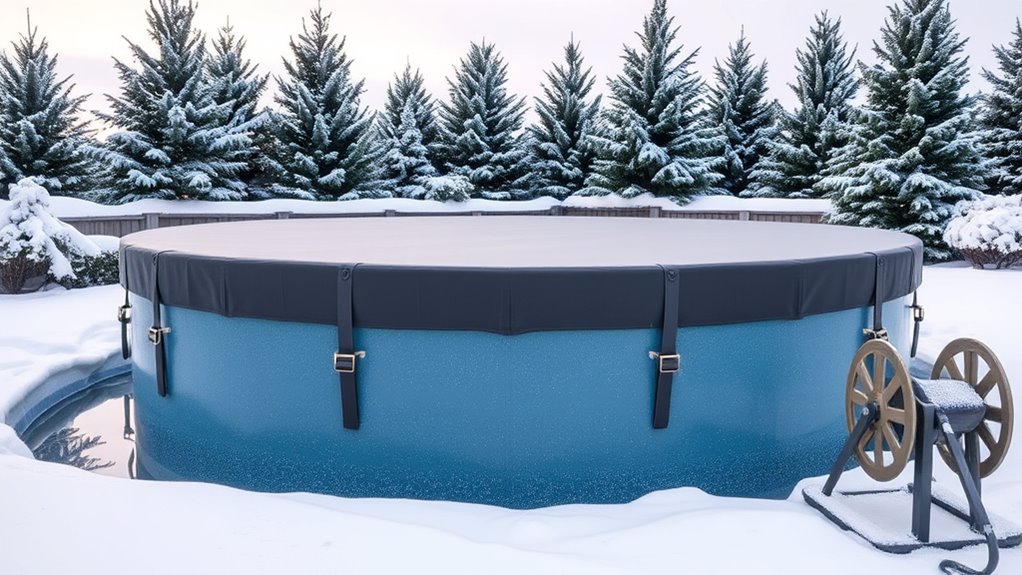
To guarantee your Endless Pool remains protected throughout the winter, it’s essential to secure the structure and cover it properly. Start by inspecting the pool’s frame for any damage or weak spots, repairing as needed. Use a high-quality, winter-specific cover to shield the pool from snow, ice, and debris. Ensure the cover fits snugly and is anchored securely to prevent it from shifting. Additionally, consider using cover clips or straps for extra stability in windy conditions. Elevate the cover slightly at the edges to promote drainage and prevent water pooling. Regularly check the cover during winter to confirm it remains tight and free of tears. Properly securing your pool structure and cover safeguards against harsh weather and prolongs its lifespan. Incorporating remote hackathons can also be a creative way to gather ideas for innovative winterization solutions from a global community.
Disconnect and Store Pool Accessories Safely
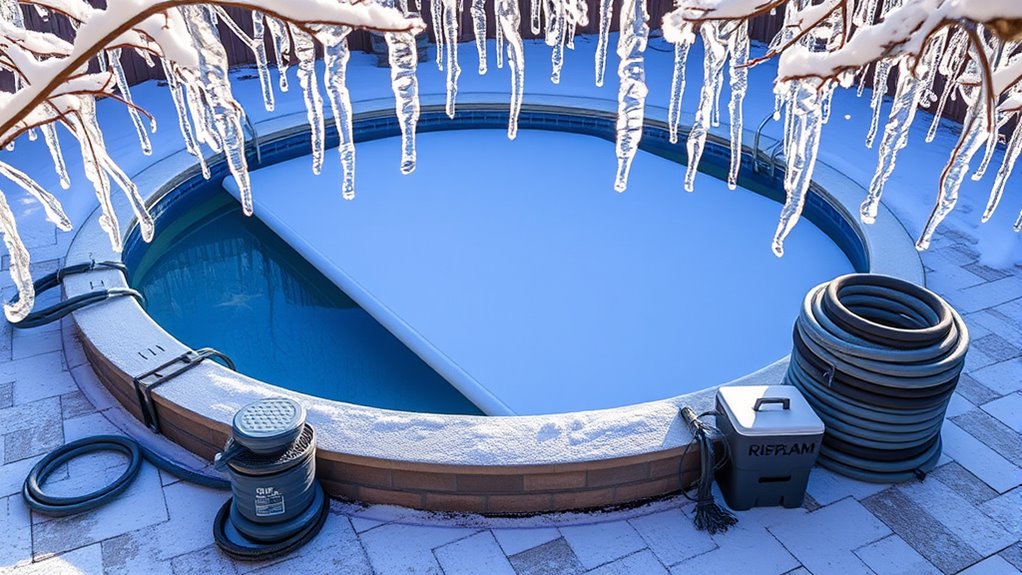
Before winter arrives, make sure to remove all pool accessories and dry them thoroughly. Store them in a dry, protected area to prevent damage from moisture or cold. Properly storing your accessories helps keep them in good condition for future use. To ensure your pool remains in optimal shape, consider checking the best free keto diet app for health tips that can support your winter wellness routine.
Remove and Dry Accessories
Since pool accessories are often exposed to water and moisture, it’s vital to remove and dry them thoroughly before winterizing. Moisture left on accessories can cause corrosion, mold, or damage over time. Carefully disconnect items like pool brushes, skimmers, ladders, and cleaning tools. Wipe each piece with a dry cloth to remove any residual water and guarantee complete dryness. Properly dried accessories prevent rust and deterioration during the cold months. To maintain quality, consider inspecting accessories for cracks or damage before storage. Handling accessories with care now will extend their lifespan and guarantee they’re ready for use when warmer weather returns. Remember, dry, well-maintained accessories contribute to a smoother winterization process and a more straightforward start-up next season. Additionally, keeping detailed notes or tracking occurrences of angel numbers can provide spiritual guidance during the winter months, fostering peace and clarity.
- Disconnect all hoses and fittings
- Wipe accessories with a clean, dry cloth
- Inspect for damage or wear
- Dry in a well-ventilated area
- Store in a dry, protected space
Store in Dry Area
Are you guaranteeing your pool accessories are stored safely and properly? Proper storage prevents damage and extends their lifespan. After removing and drying your accessories, store them in a dry, sheltered area away from the elements. Keep small parts in labeled containers to avoid loss. Make sure all items are completely dry before storing to prevent mold and corrosion. To emphasize, consider this table:
| Tip | Benefit |
|---|---|
| Store in a dry area | Prevents rust and mold |
| Keep in labeled containers | Easy to find accessories |
| Avoid direct sunlight | Prevents material degradation |
| Use protective covers | Adds extra protection |
Taking these steps ensures your accessories stay in top condition until next season. Proper storage makes winter maintenance easier and more effective.
Maintain Proper Air Circulation and Ventilation
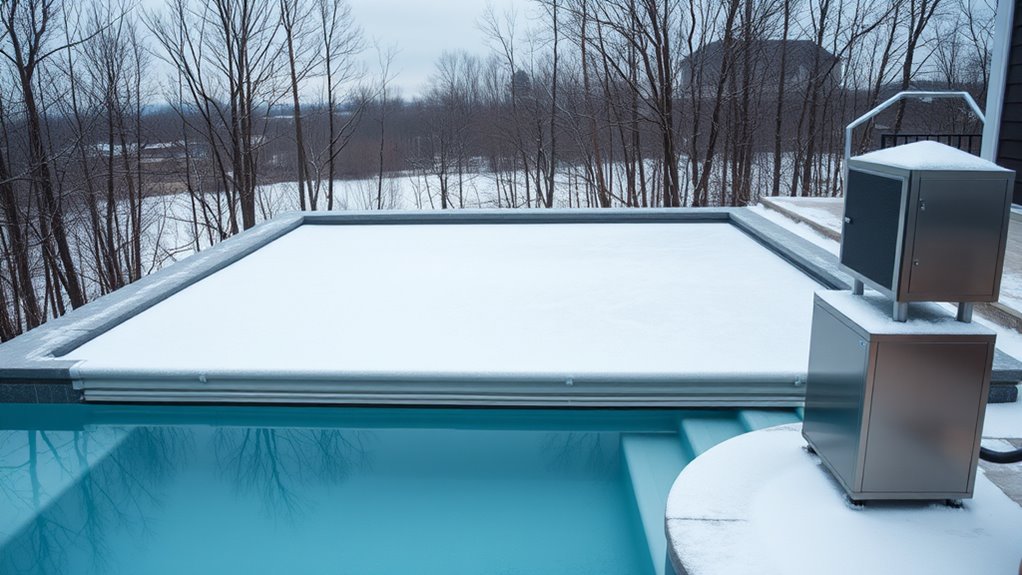
Maintaining proper air circulation and ventilation is essential to guarantee your pool area stays dry during winter. Effective airflow prevents moisture buildup, which can lead to mold, mildew, and corrosion. Confirm vents are unobstructed and functioning correctly. Use exhaust fans to remove humid air and promote fresh airflow. Regularly open windows or vents when weather permits to facilitate cross-ventilation. Keep an eye on humidity levels, ideally between 30-50%, to prevent condensation. Proper ventilation also helps in controlling temperature fluctuations, reducing the risk of frozen pipes. Consider installing dehumidifiers if your space tends to retain moisture. Remember these key points:
- Keep vents and exhaust fans unobstructed
- Use dehumidifiers as needed
- Open windows periodically for fresh air
- Monitor humidity levels regularly
- Ensure proper insulation for air pathways
It is also important to understand the role of air circulation in preventing moisture-related issues, as proper airflow can significantly reduce the risk of mold and mildew growth in your pool area.]
Schedule Regular Checks During the Off-Season
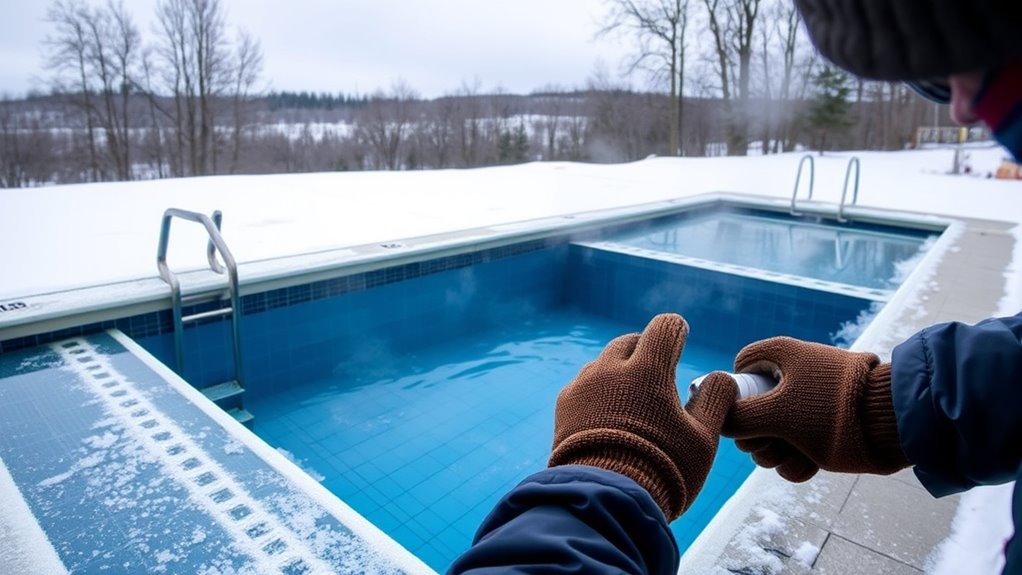
Scheduling regular checks during the off-season keeps your pool in top condition and prevents costly damage. During this time, inspect for leaks, rust, or debris that could cause issues later. Check the pump, filters, and plumbing connections to ensure they’re secure and functioning properly. Also, look for signs of freezing or ice buildup, which can damage components. Regular inspections help catch small problems before they escalate. Use this table to keep your maintenance organized: | Task | Frequency | Notes | |—————————-|—————-|——————————| | Inspect for leaks | Monthly | Seal small leaks immediately | | Check water level | Bi-weekly | Maintain proper height | | Clean filters | Monthly | Prevent debris buildup | | Test system operation | Quarterly | Ensure all parts work | Staying informed about AI safety developments can help anticipate future risks that might impact your pool equipment or control systems, ensuring a safer and more reliable operation.
Prepare for Spring Reopening to Ensure a Smooth Restart
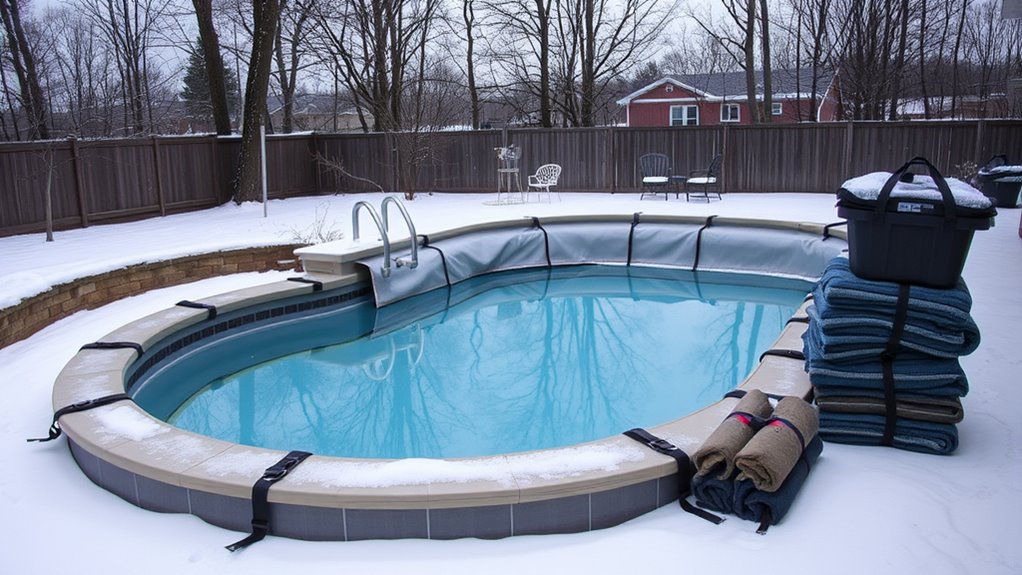
As winter ends, it’s essential to start preparing your Endless Pool for the spring reopening to guarantee a smooth shift back to regular use. Begin by inspecting the entire system for any damage or wear caused during the off-season. Clear out any debris from the filter and skimmer baskets. Check the chemical balance, ensuring the water is properly sanitized and pH levels are within range. Reconnect power and run the pump to circulate water and verify everything functions correctly. Finally, perform a thorough cleaning of the pool’s surface and surrounding area. Consider the following steps to streamline the process:
- Inspect and replace any damaged seals or fittings
- Test and calibrate the filtration system
- Refill with fresh water if necessary
- Review your chemical treatment plan
- Schedule a professional service if needed
Frequently Asked Questions
Can I Winterize My Endless Pool Myself or Should I Hire a Professional?
You can winterize your endless pool yourself if you’re comfortable with DIY tasks and follow proper procedures. However, hiring a professional ensures the job’s done correctly, especially if you’re unsure about draining, cleaning, and protecting the equipment from freezing temperatures. Professionals bring expertise and can save you time and potential mistakes. Consider your experience and comfort level before deciding whether to do it yourself or call in a specialist.
How Long Does the Winterization Process Typically Take?
Winterizing your endless pool usually takes about 2 to 4 hours, depending on its size and your experience. You’ll drain the water, clean the filters, and disconnect equipment, which can be done relatively quickly if you’re familiar with the process. Take your time to make certain everything’s properly prepared for winter. Rushing can lead to overlooked steps, so plan accordingly and have all your supplies ready beforehand.
What Are Common Mistakes to Avoid During Winterization?
You should avoid rushing the winterization process, as skipping steps or rushing can cause damage. Never forget to drain the water completely, and don’t leave equipment unprotected from freezing temperatures. Avoid using harsh chemicals that can harm your pool components, and don’t neglect to disconnect and store accessories properly. Ultimately, don’t ignore manufacturer instructions, since improper winterization can lead to costly repairs or pool damage come spring.
Is It Necessary to Drain the Entire Pool or Just Part of It?
You don’t need to drain the entire pool, only the water to the appropriate level recommended by your manufacturer. This prevents freezing damage to the plumbing and equipment. Make sure to drain the filter and pump, and blow out the lines if necessary. Leaving some water in the pool helps protect it during winter, but avoid overfilling to prevent potential damage from expanding ice.
How Do I Know When It’s Safe to Reopen My Pool in Spring?
You’ll know it’s safe to reopen your pool in spring when the outdoor temperatures stay above 50°F consistently, and the risk of frost has passed. Check for clear, algae-free water, and run your filtration system to guarantee everything’s functioning properly. Test the water chemistry, and inspect all equipment for damage. Once everything looks good, gradually remove covers and start your pool to enjoy it safely again.
Conclusion
So, after all that winterizing, you might think your endless pool is invincible. But ironically, neglecting these steps could turn your winter wonderland into a frozen nightmare come spring. Stay vigilant, follow the guide, and enjoy a seamless reopening. Because nothing says “smart pool owner” like being prepared enough to keep your pool pristine, even when it’s hibernating. After all, who knew winter could be so… enlightening?
